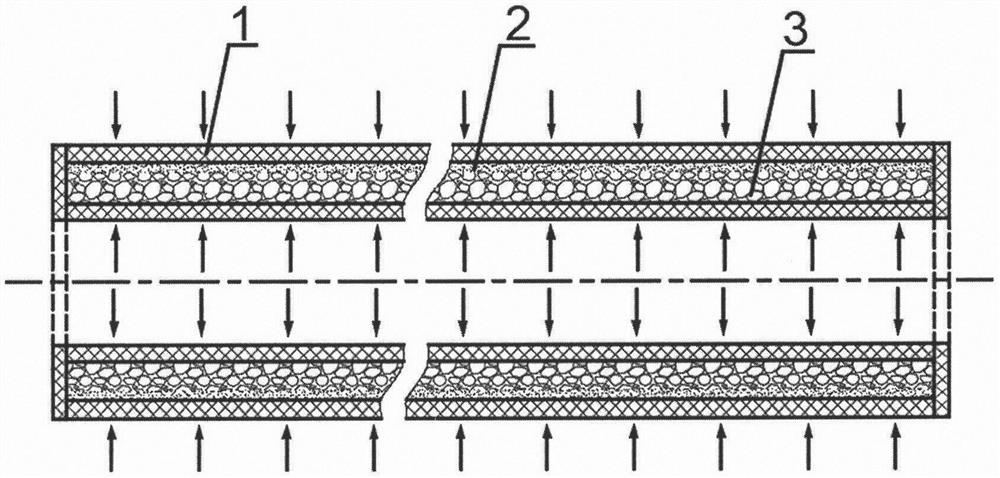Manufacturing method of filter material
A manufacturing method and filter material technology, applied in separation methods, chemical instruments and methods, filtration and separation, etc., can solve the problems of poor filtration performance, defective products, easy damage, etc., and achieve low production costs, improve binding force, membrane The effect of narrow pore size distribution
- Summary
- Abstract
- Description
- Claims
- Application Information
AI Technical Summary
Problems solved by technology
Method used
Image
Examples
Embodiment 1
[0028] 1) A porous titanium tube with an outer diameter of 10 mm, a wall thickness of 2 mm, a length of 20 cm, and an average pore diameter of 6 μm was selected as the base material, cleaned ultrasonically with ethanol, and dried.
[0029] 2) Weigh 20 g of titanium powder with an average particle diameter of 2 μm, add it to 250 ml of 2% polyvinyl butyral (PVB) ethanol solution, and stir for 6 hours. Spray the prepared powder slurry onto the surface of the porous titanium tube by spraying to form a uniform continuous coating, and let it dry naturally.
[0030] 3) Spray a layer of liquid paraffin evenly on the surface of the coating as a release agent, and seal the titanium tube with an elastic rubber sleeve, such as figure 1 shown. Put into cold isostatic pressing equipment and press, and the pressing pressure is 100MPa.
[0031] 4) Remove the elastic rubber sleeve, carry out vacuum sintering on the taken-out green body, raise the temperature to 1000°C at a rate of 4°C / min, k...
Embodiment 2
[0033] 1) Use a porous nickel tube with an outer diameter of 24mm, a wall thickness of 3mm, a length of 50cm, and an average pore diameter of about 12μm as the base material, and use 1000-mesh sandpaper to polish the surface spikes, first brush it, then rinse it with water, and dry it.
[0034] 2) Take 50g of nickel powder with an average particle diameter of 4 μm, add it to 500ml of 3% polyvinyl alcohol (PVA) aqueous solution, stir for 10 hours, brush the prepared powder slurry on the surface of the porous nickel tube to form Uniform continuous coating, dried in a vacuum oven.
[0035] 3) With step 3) in embodiment 1, but pressing pressure is 80MPa.
[0036] 4) Remove the elastic rubber sleeve, raise the temperature of the taken-out body to 1030° C. at a rate of 6° C. / min in an argon atmosphere, keep it warm for 2 hours, and cool naturally to room temperature to prepare a porous nickel membrane filter material.
Embodiment 3
[0038] 1) A porous stainless steel tube with an outer diameter of 36 mm, a wall thickness of 3 mm, a length of 40 cm, and an average pore diameter of 30 μm is selected as the matrix material, and the surface is blown with compressed air, and the pores are blown from the inside to the outside.
[0039] 2) Weigh 120 g of stainless steel powder with an average particle diameter of 6 μm, add it to 800 ml of 4% polyethylene glycol (PEG) isopropanol solution, and stir for 12 hours. The prepared powder slurry was deposited on the inner surface of the porous stainless steel substrate by suction method to form a uniform continuous coating, which was then dried naturally.
[0040] 3) Spray a layer of glycerin evenly on the surface of the coating as a release agent, and use an elastic rubber sleeve to seal the porous stainless steel tube, such as figure 2 shown. Put it into cold isostatic pressing equipment for pressing, and the pressing pressure is 90MPa.
[0041] 4) Remove the elast...
PUM
| Property | Measurement | Unit |
|---|---|---|
| particle size | aaaaa | aaaaa |
| thickness | aaaaa | aaaaa |
| pore size | aaaaa | aaaaa |
Abstract
Description
Claims
Application Information
 Login to View More
Login to View More - R&D
- Intellectual Property
- Life Sciences
- Materials
- Tech Scout
- Unparalleled Data Quality
- Higher Quality Content
- 60% Fewer Hallucinations
Browse by: Latest US Patents, China's latest patents, Technical Efficacy Thesaurus, Application Domain, Technology Topic, Popular Technical Reports.
© 2025 PatSnap. All rights reserved.Legal|Privacy policy|Modern Slavery Act Transparency Statement|Sitemap|About US| Contact US: help@patsnap.com


